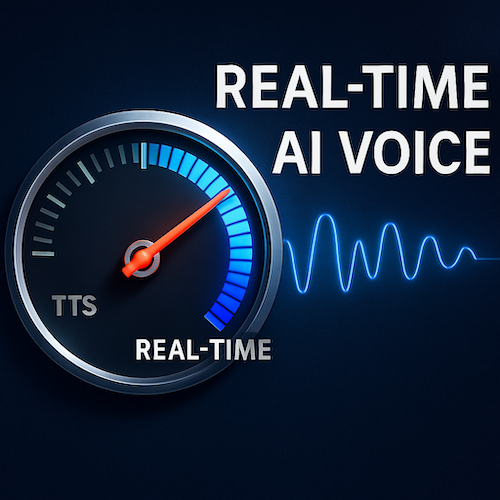Real-Time AI Voice vs Traditional TTS: Why Speed Changes Everything

Text-to-Speech (TTS) is no longer just about voice quality. In 2025, it’s about speed — and whether your app can hold a user’s attention during a live interaction.
That’s where real-time AI voice changes the game. Whether you're building an AI companion, phone-based assistant, or immersive game, latency is the difference between feeling magical and falling flat.
Let’s break down the core differences between traditional TTS and real-time AI voice, and explain why it matters more than ever.
Traditional TTS: Great for Static Content, Terrible for Conversations
Traditional TTS systems were designed for:
- Reading scripts
- Announcements
- Static audio generation (IVR, e-learning, etc.)
They generally follow a request → process → return audio flow. It might take a few seconds — sometimes more — for the audio to be synthesized. That’s fine for reading an FAQ or narrating a blog post, but for live conversations, it’s a dealbreaker.
Key weaknesses:
- 🐢 High latency (1–5 seconds typical)
- 🧊 No streaming — audio delivered only after full processing
- 🎭 Unnatural pauses destroy the user experience
Real-Time AI Voice: The Future of Conversational UX
Gabber’s real-time AI voice models stream audio in 200–500ms. That’s fast enough to feel like you’re talking to a real person. Users can:
- Interrupt mid-sentence
- Speak naturally
- Stay immersed
This opens up new UX patterns:
- 🔁 Back-and-forth dialogue loops (like real conversations)
- 🕹️ AI NPCs that talk and react in real-time
- 📱 Phone bots that don’t leave awkward silences
- 🧠 Coaching or therapy bots with emotional pacing
It feels alive — not like reading a Wikipedia article out loud.
Comparing Traditional TTS vs Real-Time Voice
| Feature | Traditional TTS | Gabber (Real-Time) |
|---|---|---|
| Latency | 1–5 seconds | 200–500ms |
| Streaming | ❌ No | ✅ Yes |
| Interruptability | ❌ No | ✅ Yes |
| Use Case Fit | Static narration, voiceovers | Live apps, AI characters, phone AI |
| Cost | Per character/token | $1/hr (Orpheus), $3/hr (Cartesia) |
Why Speed Unlocks New Use Cases
Real-time responsiveness is the foundation for:
- Immersion in voice-first AI apps
- Retention in gamified interactions
- Conversion in voice-based sales flows
If your app can talk back instantly — with tone, emotion, and memory — users stick around longer and feel like they’re talking to something real.
Real Use Cases with Real-Time Voice
✅ AI Companions: Natural, real-time conversations with synthetic personalities
✅ Therapy Bots: Interruptable voice lets users speak freely and emotionally
✅ Voice-First Games: Real-time AI characters respond like human players
✅ Phone Interfaces: IVR is dead. Live AI voice on the line is the future.
If your product needs voice + interactivity, traditional TTS will never get you there.
TL;DR: Don’t Build a Voice App Without Real-Time Voice
If your AI voice doesn’t respond in real time, it’s just... reading.
And reading isn’t engaging.
Conversation is.
Gabber gives you the infrastructure to build fast, responsive, expressive AI voice apps — priced for scale, and designed for UX.
🎙️ Ready to build? Start using Gabber